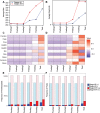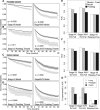A Temporal Examination of Platelet Counts as a Predictor of Prognosis in Lung, Prostate, and Colon Cancer Patients
- PMID: 29700384
- PMCID: PMC5920102
- DOI: 10.1038/s41598-018-25019-1
A Temporal Examination of Platelet Counts as a Predictor of Prognosis in Lung, Prostate, and Colon Cancer Patients
Abstract
Platelets, components of hemostasis, when present in excess (>400 K/μL, thrombocytosis) have also been associated with worse outcomes in lung, ovarian, breast, renal, and colorectal cancer patients. Associations between thrombocytosis and cancer outcomes have been made mostly from single-time-point studies, often at the time of diagnosis. Using laboratory data from the Department of Veterans Affairs (VA), we examined the potential benefits of using longitudinal platelet counts in improving patient prognosis predictions. Ten features (summary statistics and engineered features) were derived to describe the platelet counts of 10,000+ VA lung, prostate, and colon cancer patients and incorporated into an age-adjusted LASSO regression analysis to determine feature importance, and predict overall or relapse-free survival, which was compared to the previously used approach of monitoring for thrombocytosis near diagnosis (Postdiag AG400 model). Temporal features describing acute platelet count increases/decreases were found to be important in cancer survival and relapse-survival that helped stratify good and bad outcomes of cancer patient groups. Predictions of overall and relapse-free survival were improved by up to 30% compared to the Postdiag AG400 model. Our study indicates the association of temporally derived platelet count features with a patients' prognosis predictions.
Conflict of interest statement
The authors declare no competing interests.
Figures





References
-
- McCarty OJ, Mousa SA, Bray PF, Konstantopoulos K. Immobilized platelets support human colon carcinoma cell tethering, rolling, and firm adhesion under dynamic flow conditions. Blood. 2000;96:1789–1797. - PubMed
-
- Nieswandt B, Hafner M, Echtenacher B, Männel DN. Lysis of tumor cells by natural killer cells in mice is impeded by platelets. Cancer Res. 1999;59:1295–1300. - PubMed
Publication types
MeSH terms
Substances
Grants and funding
LinkOut - more resources
Full Text Sources
Other Literature Sources
Medical
Research Materials

